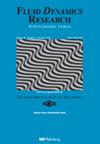Effects of a spherical slip cavity filled with micropolar fluid on a spherical micropolar droplet
IF 1.3
4区 工程技术
Q3 MECHANICS
引用次数: 0
Abstract
In this work, a two-fluid phase flow problem involving an axisymmetrical quasi-steady motion of a spherical micropolar droplet translating at a concentric point in a second non-mixable micropolar fluid within a spherical impermeable cavity with a slip surface is analysed under low Reynolds numbers. The two fluid phases that have a microstructure (micropolar fluid) are the case that is being focused on. The Stokes equations are solved inside and outside the droplet for the velocity fields. In addition, based on the concentric position, general solutions in terms of spherical coordinates are obtained. In this case, tangential couple stress and continuity of microrotation are used. For different cases, the normalised drag forces acting on the droplet are represented via graphs for different values of relative viscosity, droplet-to-cavity radii ratio, and the parameter that connects the tangential couple stress with microrotation. The normalised drag force is found to be a monotonically increasing function of the drop-to-cavity radii ratio. It is found that when the droplet-to-cavity radii ratio approaches zero, there is a very strong interaction between the droplet and the cavity. When comparing a solid sphere to a gas bubble, the normalised drag force is larger. Additionally, the results showed that permitting spin and slip at the cavity’s interior surface improved the wall correction factor influencing the droplet. The present study is important in the fields of natural, industrial, and biomedical processes such as raindrop formation, liquid–liquid extraction, suspension rheology, sedimentation, coagulation, and the motion of blood cells in an artery or vein.充满微极性流体的球形滑动腔对球形微极性液滴的影响
本研究分析了低雷诺数条件下的双流体相流问题,即在一个带滑移面的球形不透水空腔内,球形微波液滴在第二种不可混合微波流体中的同心点处平移的轴对称准稳态运动问题。重点分析了具有微结构的两相流体(微极流体)的情况。对液滴内部和外部的速度场求解斯托克斯方程。此外,根据同心位置,还得到了球面坐标的一般解法。在这种情况下,使用切向耦合应力和微旋转连续性。在不同情况下,作用在液滴上的归一化阻力通过不同的相对粘度值、液滴与空腔半径比以及将切向耦合应力与微自转联系起来的参数用图表表示。发现归一化阻力是液滴与空腔半径比的单调递增函数。研究发现,当液滴与空腔的半径比接近零时,液滴与空腔之间会产生很强的相互作用。将固体球体与气体气泡相比,归一化阻力更大。此外,研究结果表明,允许空腔内表面的自旋和滑动可提高影响液滴的壁面修正系数。本研究对自然、工业和生物医学过程,如雨滴形成、液液萃取、悬浮流变、沉降、凝结以及血细胞在动脉或静脉中的运动等领域具有重要意义。
本文章由计算机程序翻译,如有差异,请以英文原文为准。
求助全文
约1分钟内获得全文
求助全文
来源期刊

Fluid Dynamics Research
物理-力学
CiteScore
2.90
自引率
6.70%
发文量
37
审稿时长
5 months
期刊介绍:
Fluid Dynamics Research publishes original and creative works in all fields of fluid dynamics. The scope includes theoretical, numerical and experimental studies that contribute to the fundamental understanding and/or application of fluid phenomena.
 求助内容:
求助内容: 应助结果提醒方式:
应助结果提醒方式:


